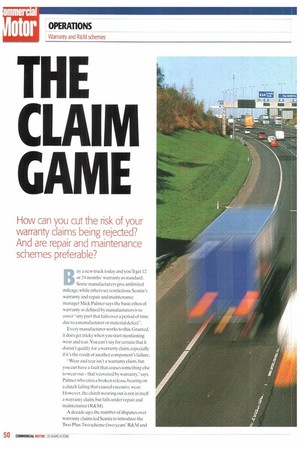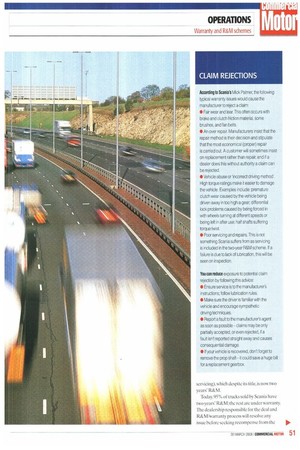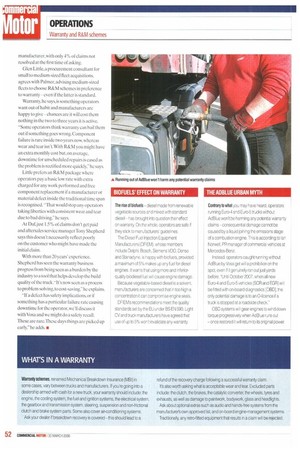THE CLAIM GAME
Page 50

Page 51

Page 52

If you've noticed an error in this article please click here to report it so we can fix it.
How can you cut the risk of your warranty claims being rejected?
And are repair and maintenance schemes preferable?
Buy a new truck today and you'll get 12 or 24 months' warranty as standard. Some manufacturers give unlimited mileage, while others set restrictions. Scania's warranty and repair and maintenance manager Mick Palmer says the basic ethos of warranty as defined by manufacturers is to cover "any part that fails over a period of time due to a manufacturer or material defect".
Every manufacturer works to this. Granted, it does get tricky when you start mentioning wear and tear. You can't say for certain that it doesn't qualify for a warranty claim, especially if it's the result of another component's failure.
"Wear and tear isn't a warranty claim, but you can have a fault that causes something else to wear out— that's covered by warranty," says Palmer who cites a broken release bearing on a clutch failing that caused excessive wear. However, the clutch wearing out is not in itself a warranty claim, but falls under repair and maintenance (R&M).
A decade ago, the number of disputes over warranty claims led Scania to introduce the Two-Plus-Two scheme (two years' R&M and servicing), which despite its title, is now two years' R&M.
Today, 95% of trucks sold by Scania have two years R&M; the rest are under warranty. The dealership responsible for the deal and R&M/warranty process will resolve any issue before seeking recompense from the manufacturer, with only 4% of claims not resolved at the first time of asking.
Glen Little, a procurement consultant for small to medium-sized fleet acquisitions, agrees with Palmer, advising medium-sized fleets to choose R&M schemes in preference to warranty even if the latter is standard.
Warranty, he says, is something operators want out of habit and manufacturers are happy to give -chances are it will cost them nothing in the two to three years it is active. "Some operators think warranty can bail them. out if something goes wrong. Component failure is rare inside two years now. whereas wear and tear isn't.With R&M you might have an extra monthly cost but, on average, downtime for unscheduled repairs is eased as the problem is rectified more quickly," he says.
Little prefers an R&M package where operators pay a basic low rate with extra charged for any work performed and free component replacement if a manufacturer or material defect inside the traditional time span is recognised. "That would stop any operators taking liberties with consistent wear and tear due to bad driving." he says.
At Daf, just 1.5% of claims don't. get paid and aftersales service manager Tony Shepherd says this doesn't necessarily reflect poorly on the customer who might have made the initial claim.
With more than 20 years' experience, Shepherd has seen the warranty business progress from being seen as a burden by the industry to a tool that helps develop the build quality of the truck."It's now seen as a process to problem-solving, to cost-saving," he explains.
"If a defect has safety implications, or if something has a particular failure rate causing downtime for the operator, we'll discuss it with Vosa and we might do a safety recall. These are rare,These days things are picked up early," he adds. •






























































































































































































